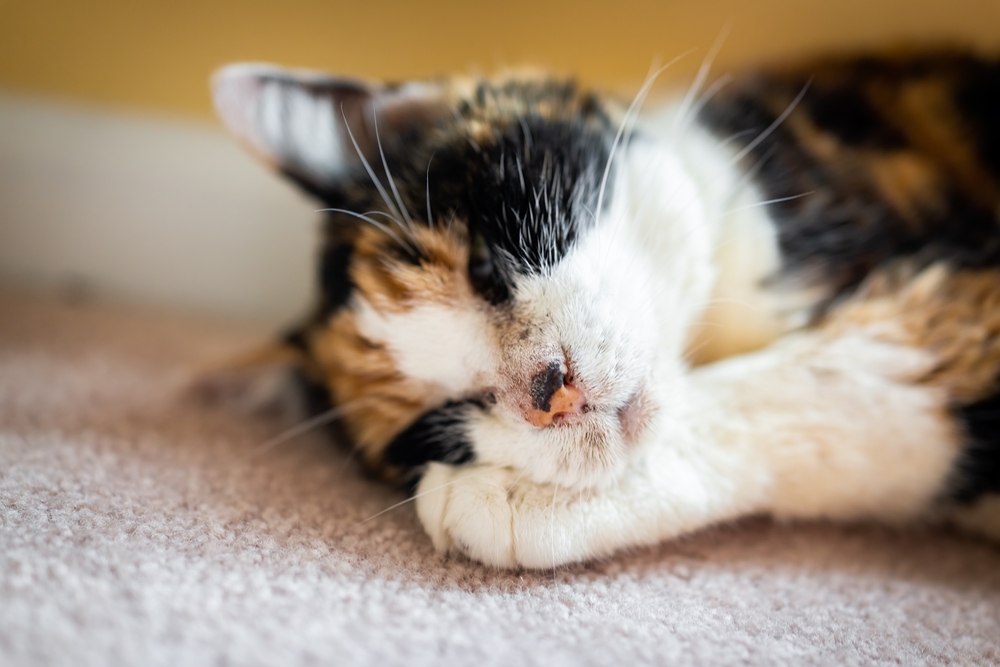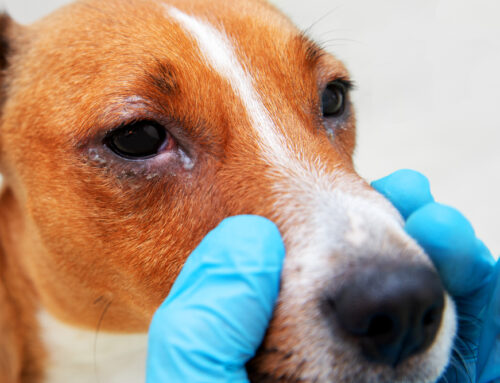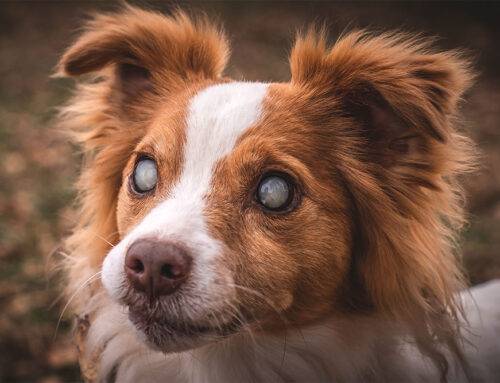A healthy pet’s eyes produce a tear film that helps to lubricate, protect, and nourish the eyes, giving them a healthy, bright appearance. Tears have several layers, including watery, mucous, and oil portions that work together for optimal health, but an eye irritation, infection, or chronic disease can upset this balance and lead to excessive tearing or thick, gooey (i.e., mucoid) discharge. The Veterinary Vision Center team wants pet owners to understand common underlying eye discharge causes in pets and how we treat these diseases.
#1: Dry eye disease in pets
Dry eye disease (i.e., keratoconjunctivitis sicca) commonly affects dogs, but rarely affects cats. Dogs with dry eye either have a watery component deficiency or a poor-quality tear film that evaporates too quickly. Dry eye disease signs include redness, squinting, rubbing, and a thick, mucoid, persistent discharge that keeps coming back, no matter how frequently you clean or rinse your pet’s eyes.
Dry eye disease can lead to corneal abrasions, scarring, or discoloration that may impair vision over time. Treatments include eye drops or oral medications that stimulate tear production, steroid eye drops to reduce scarring and inflammation, and possible surgery in severe cases.
#2: Conjunctivitis in pets
Conjunctivitis is not a disease, but indicates another underlying problem. Inflamed conjunctiva, the translucent tissue lining the eyelids and eye whites, often leads to a watery or mucoid discharge. In cats, upper respiratory infection with herpesvirus, calicivirus, or chlamydia are the most common conjunctivitis causes, while in dogs, environmental allergies, irritation from dust and other airborne particles, immune system immaturity in young dogs, or infections (e.g., kennel cough, canine influenza) are the most common causes. Distemper or adenovirus can cause serious conjunctivitis in young puppies, but is less likely in vaccinated adults.
Conjunctivitis treatments eliminate the underlying cause and address inflammation. Options may include oral allergy medications, antibiotics and topical antibiotics, antivirals, or liquid or ointment anti-inflammatories.
#3: Eyelid and eyelash abnormalities in pets

Pets born with eyelid or eyelash abnormalities often suffer at a young age from chronic corneal irritation, as the abnormal hairs rub on the eye surface, leading to watery eyes. Abnormalities also occasionally develop in older pets. Signs include moisture around the eyes, brown staining, squinting, and redness. Most eyelid or eyelash abnormalities, including entropion (i.e., eyelids rolling inward), distichiasis (i.e., extra eyelashes), ectopic cilia (i.e., hairs growing from the eyelid underside), and eyelid agenesis (i.e., malformed eyelids), require surgical correction.
#4: Tear duct abnormalities in pets
Tear ducts are small tubes that drain tears from the eyes into the back of the nose or mouth. When tear ducts become blocked, the tears have nowhere to go and will chronically spill over onto the face. Excessive tearing is usually the only sign of a blocked tear duct, but a bump can form if infection or abscess is the cause. Some pets are born with abnormal ducts and small openings, and some pets can develop a blockage from inflammation. Flushing the ducts—a quick outpatient procedure—can sometimes clear a blockage, but others need surgical correction. A blocked tear duct surgery is often cosmetic, so many pet owners opt to manage the signs rather than pursue invasive surgery.
#5: Eye ulcers in pets
Corneal abrasions and scratches, commonly known as corneal ulcers, can happen for many reasons in dogs and cats. Signs include eye redness, squinting, and watery discharge, and a thick yellow or green discharge if the ulcer becomes infected. Pets commonly develop an eye ulcer because of viral infections, self-trauma from rubbing, eye injuries, eyelid or eyelash abnormalities, corneal diseases, dry eye, and age. Eye ulcer treatment includes protecting the eye from self-trauma with an Elizabethan collar (i.e., cone) and administering antibiotic eye drops to prevent infection. Deep ulcers can lead to eye rupture and subsequent blindness or eye loss and require surgery.
Eye discharge indicates that your pet has an underlying eye or systemic condition. Except for congenital tear duct problems, these conditions require veterinary treatment to keep your pet’s eyes comfortable and visual. Contact the Veterinary Vision Center team for evaluation and treatment if your pet develops eye discharge or other signs of eye discomfort.






Leave A Comment